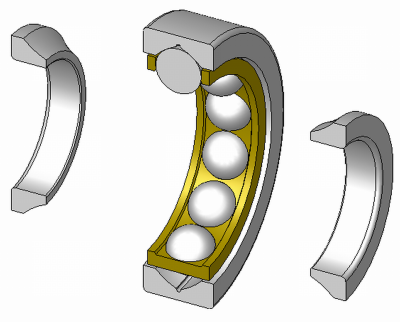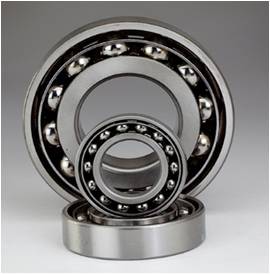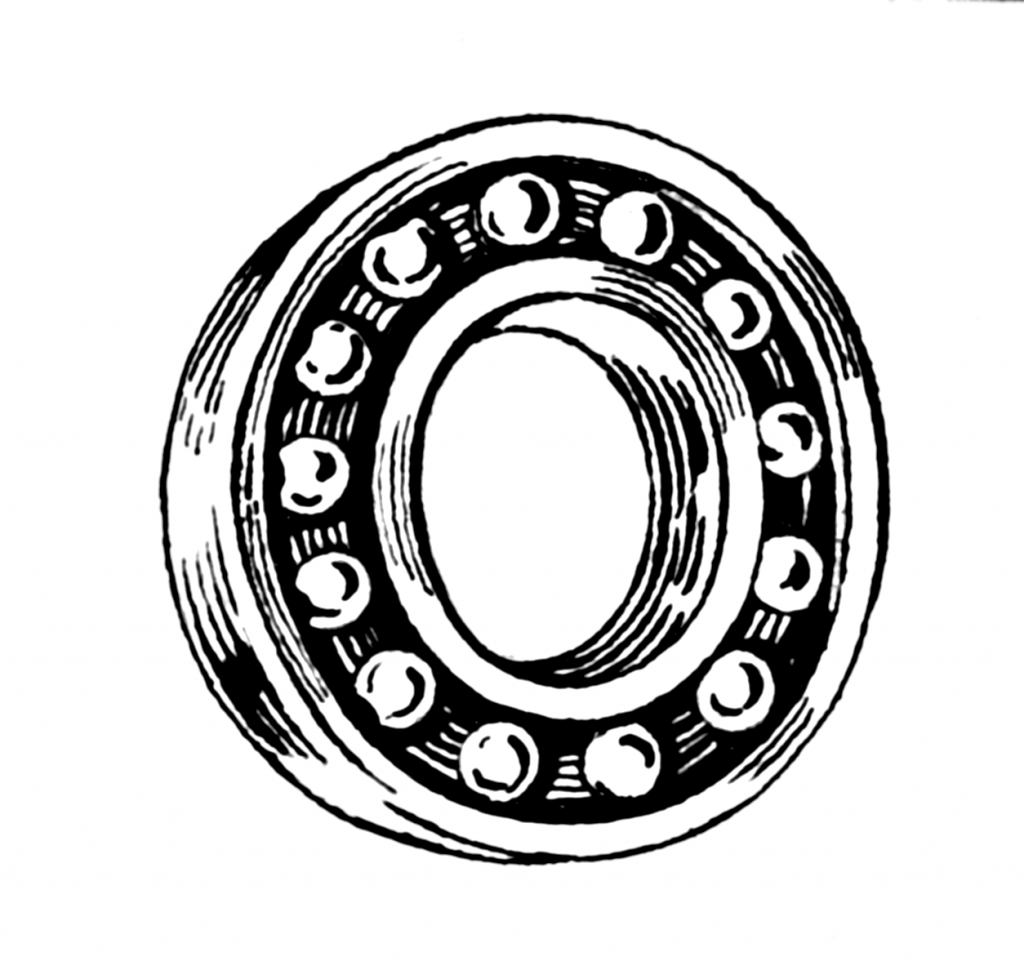Now as I beheld the Chayot [living creatures], behold one Ophan [wheel] at the bottom hard by the living creatures, at the four faces thereof. The appearance of the Ophanim [wheels] and their work was like unto the colour of a beryl; and they four had one likeness; and their appearance and their work was as it were a wheel within a wheel. . . . As for their rings, they were high and they were dreadful; and they four had their rings full of eyes round about.
Ezekiel 1:15–18
One of the most difficult theological questions is how Eternal G‑d relates to the world created by Him, the world that is always in flux. Indeed, the prophet Malachi says in the name of G‑d:
For I the Eternal change not.
Malachi 3:6
G‑d does not change, because He is above time that had been created by Him. Time as a creation does not limit G‑d. The proper name of G‑d, Y-H-W-H, is interpreted as the acronym for I was, I am, and I will be, stressing that G‑d does not change and He transcends time. However, the world created by G‑d is in a permanent state of flux—time never stops. How can the eternal, unchanging G‑d, who is above time, connect and guide the world that exists in time? Where do these metaphysical opposites—timeless and temporal—meet? The prophecy of Ezekiel may provide a hint.
On the first day of the holiday of Shavuot (Pentecost), when Jews celebrate Sinaitic theophany, the Haftara (the weekly portion of the Prophets read after the Torah) is the vision of Ezekiel called Maaseh Merkava (literally “Working of the Chariot”). This is one of the most profoundly mystical visions depicting an allegory of the Divine mystery—how the Divine Presence interacts with and guides the created world through angelic beings. It is not easy to understand, because its cast of characters is made of allegorical beings that must not be understood literally. But what they mean is a closely guarded secret whose revelation is forbidden.[1]
Among the most enigmatic figures in the prophecy of Ezekiel are Ophanim (literally “wheels”; ophan is a singular “wheel,” with ophanim the plural). They are deemed angelic beings that inhabit the lowest stratum of the spiritual realm—Olam HaAsiyah Ruchni—the spiritual layer of the World of Action, the world we inhabit. What’s puzzling about them is their description:
[A]nd their appearance and their work was as it were a wheel within a wheel. . . . As for their rings, they were high and they were dreadful; and they four had their rings full of eyes round about.
Ezekiel 1:16, 1:18
Obviously, it is a metaphor. But the metaphor of what? What could a wheel within a wheel possibly signify? And the eyes. . . ? Angels are typically portrayed in human form, albeit with wings. (Needless to say, angels are spiritual forces that don’t have any shape or form—this is how they usually appear in a prophetic vision, which should not be taken literally.) Who would have thought of an angel in the form of a wheel? And not a single wheel, but a double wheel—“a wheel within a wheel”?[2] And who ever saw eyes on a wheel? As Winston Churchill would say, this image is “a riddle wrapped in a mystery, inside an enigma.”
Let us recall that Ezekiel’s vision is all about the chariot, on which G‑d’s throne rests.[3] So, it natural to assume that something that looks like a wheel—in fact, four wheels—positioned under the chariot may be just that—the wheels of the chariot. And some commentators indeed take this position. Noting that Ophanim are angelic beings that occupy the lowest stratum of the spiritual realm just above the physical world, Rabbi Aryeh Kaplan proposed that Ophanim serve as an interface of sorts between the spiritual and the physical.[4] This is where the rubber meets the road.
Yet the metaphor of a wheel as the interface between the spiritual and the physical, as insightful as it is, does not explain why there are two wheels—a wheel within a wheel. Nor does it explain the eyes all around the wheel.
To account for these details, perhaps, a slightly different explanation is required. To me, Ophanim seem more like ball bearings than wheels. Rolling-element bearings like ball bearing setups have two “wheels”—a larger outer wheel (called the outer race) and a smaller inner wheel (called the inner race) —a wheel within a wheel (or a race within a race). Each race in a ball bearing has a groove so that when the inner race is inserted inside the outer race, the two grooves facing each other form a channel. Small metal balls (often confusingly also called ball bearings) are placed in that channel between the two races.

If one looks at the ball bearing from the side, the balls may be visible and may appear as eyeballs. If you show a ball bearing to a child and ask the child to draw a picture of it, chances are that a child unfamiliar with the mechanics of a ball bearing might draw two wheels—a wheel within a wheel—with eyeballs all around.

The prophet, who never saw a ball bearing,[5] would have likely visualized it as a wheel within a wheel with eyes all around.
Once again, given the central role of the chariot in Ezekiel’s Vision of the Chariot, it is not surprising to find imagery of four ball bearings that could indeed be found in any Industrial Age chariot. The surprising thing is that Ezekiel saw them more than a thousand years before they were invented. But then, Ezekiel was a prophet, and that’s what prophets do—see the future.
What is the significance of a ball bearing, such that it is included in one of the greatest prophecies dealing with the mystery of Divine Providence? A ball bearing is meant to connect a moving wheel to a stationary axle (or shaft) to reduce friction between them. Ball bearings, like wheels, reduce friction. Wheels reduce friction between the carriage and the road, whereas ball bearings reduce friction between the axle (or shaft) and the wheel. A ball bearing provides an interface between two incompatible physical states—the state of rest and the state of motion. Therefore, it is not inconceivable that a ball bearing appears in Ezekiel’s vision as a metaphor for the interface between two ontologically distinct states—the static state of stability and the dynamic state of change.
It seems logical that Ophanim—angelic beings (that is, spiritual forces) that act as the interface between the spiritual and the physical—be allegorically described as ball bearings providing the interface between the chariot (that is, the throne of G‑d, Who never changes) and ever-changing creation. It appears that the Ophanim in Ezekiel’s Vision of the Chariot is the link that connects metaphysical opposites—timeless godliness and time-based physical creation.
The word ophan can also be translated as a cycle, not just a wheel. Elsewhere, the angelic beings are called galgalim (“circles”). Cycles hint at time, which in Kabbalistic conception is cyclical (along with forward movement, which makes a timeline look like a spiral). This translation is consistent with our proposed understanding of Ophanim as the interface between the timeless and the temporal.
The word galgalim also used to denote Ophanim hints at the Ohr Soviv (the “Surrounding Light”). The Surrounding Light is infinite light that cannot be vested in the finite vessels of the created worlds and, therefore, surrounds these worlds (unlike Ohr Pnimi, the penetrating light that is commensurate with vessels’ ability to contain it). A galgal—a circle—has no beginning and no end, which is why it is used as a metaphor for endless infinity. The round shape of the Ophanim—the wheels—is consistent with our interpretation of them as the interface between two metaphysical opposites—timeless and temporal. As far as the infinite light Ohr Sovev is concerned, there is no difference between the timeless and the temporal, between stability and change. When it comes to infinity, everything goes. Infinity includes everything and, therefore, subsumes contradictions. Perhaps it is for this reason that the shape of the Ophanim in Ezekiel’s vision had to be round.
Thus it seems that all meanings of the Ophanim are consistent with these angelic beings serving as the interface between timeless and time-based realities.
—————————–
Endnotes:
[1] In the interest of full disclosure, I never saw the Merkava (in case anybody wonders) nor do I know its secrets. What I am about to say are my own thoughts and uneducated guesses. Since no one “revealed” these secrets to me, they are not secrets, and I don’t feel compelled to keep them hidden. However, these speculations ought to be taken with a healthy dose of skepticism and a grain of salt.
[2] Rabbi Dov Ber, the Maggid of Mezeritch, described them in his first maamar as a “small wheel within a big wheel.” See Rabbi Schneur Zalman, Torah Ohr, Yitro, p. 136.
[3] According to Masters of Kabbalah, the Divine throne is a reference to the Olam ha-Beriyah (the World of Creation), whereas the vision of the likeness of the glory of G‑d is a reference to the anthropomorphic configuration of the sefirot of Atzilut—the World of Emanation.
[4] Aryeh Kaplan, Inner Space (Moznaim Publishing Company, Jerusalem, 1990), p. 33.
[5] The modern ball bearing was designed by the Welsh inventor Philip Vaughan, who patented it in 1794. However, earlier drawings of a ball bearing are found in sketches of Leonardo da Vinci (who designed it for his helicopter around 1500) and shortly thereafter (in 1588) in the sketches of Italian engineer Agostino Ramelli.

Possibly related to Euclid Geometry and Golden Ratio? Wheels within wheels might be the type of spiral or related to the “Vesica Pisces” concept? The rims of the wheels “full of eyes” constitute geometric shapes of a circle and the circumference “full of” helixes. Or the shape of a fish. And being “full of” indicates there is no space between each helix. They are connected together in a continuous strand.
I would propose the number of “eye” shapes in the circumference of the circle is a prime number.
The four “faces” of the living creature is a quantity of characteristics.
The Wheels span the space between the firmament of Earth and Heaven.
The Living Creatures move in linear directions up and down or back and forth.
All 4 Creatures move instantaneously at the same time, same direction, same distance, same speed. “When they move” means they are stationary at times. Kinetic Energy. They must receive divine “order” from G‑d for this to occur.
The velocity of movement is “as a flash of lightning” or the speed of light…
There is also reference to the appearance of a “bow” which is refracted or divided light.
There is much more to this than I can write and is much higher than I can comprehend.
I understand why Ezekiel was “astonished” and in total shock after he saw this vision.
If there might be any more research on Ezekiel’s vision I would be very interested.
Sincerely and many Blessings,
Art Hulme
Prophet Daniel also had the same vision as Ezekiel.
Daniel 7:9 KJV
[9] I beheld till the thrones were cast down, and the Ancient of days did sit, whose garment was white as snow, and the hair of his head like the pure wool: his throne was like the fiery flame, and his wheels as burning fire.
Also this… 1 Kings 7:30-35 KJV
[30] And every base had four brasen wheels, and plates of brass: and the four corners thereof had undersetters: under the laver were undersetters molten, at the side of every addition. [31] And the mouth of it within the chapiter and above was a cubit: but the mouth thereof was round after the work of the base, a cubit and an half: and also upon the mouth of it were gravings with their borders, foursquare, not round. [32] And under the borders were four wheels; and the axletrees of the wheels were joined to the base: and the height of a wheel was a cubit and half a cubit. [33] And the work of the wheels was like the work of a chariot wheel: their axletrees, and their naves, and their felloes, and their spokes, were all molten. [34] And there were four undersetters to the four corners of one base: and the undersetters were of the very base itself. [35] And in the top of the base was there a round compass of half a cubit high: and on the top of the base the ledges thereof and the borders thereof were of the same. …
I don’t believe the description is a metaphor. I had this appear before me after a near death experience. I didn’t know what it was until today. The rings are layered and at certain intervals there are round forms that could me seen as eyes or “balls”. With my background in physics it looked more to me of how electrons would stand out in an orbit. I stared at it and didn’t permit myself to be afraid telling myself, “you are only supposed to fear G-d. Being afraid of this thing would then be unfaithful to G-d.” I stared until I couldn’t see it any longer. The rings had movement but the movement was so fast it appeared to be still.
I am sorry to hear that you had a near-death experience. Thank you for sharing your experience.